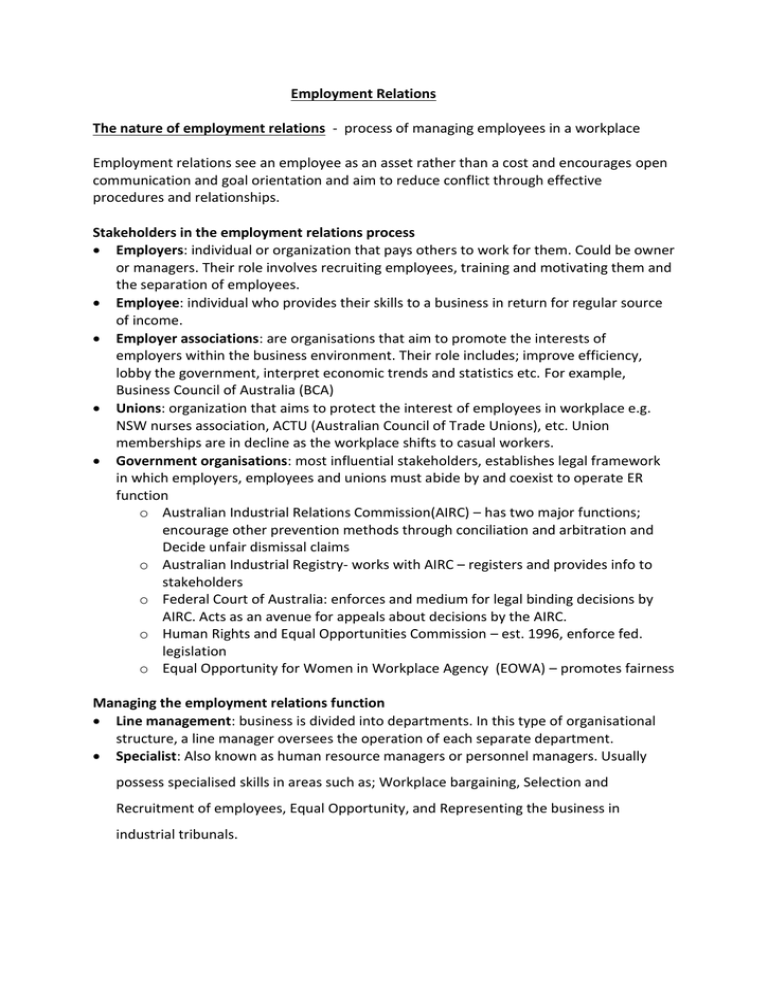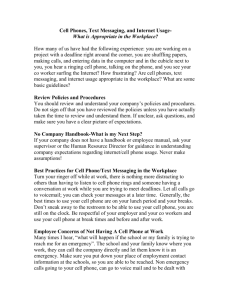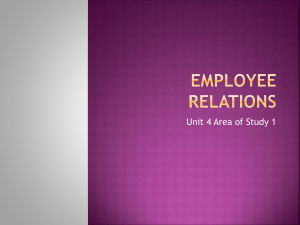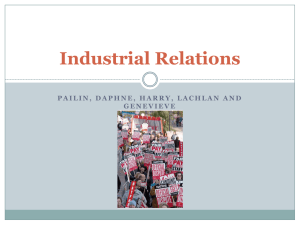Employment Relations The nature of employment relations
advertisement

Employment Relations The nature of employment relations - process of managing employees in a workplace Employment relations see an employee as an asset rather than a cost and encourages open communication and goal orientation and aim to reduce conflict through effective procedures and relationships. Stakeholders in the employment relations process Employers: individual or organization that pays others to work for them. Could be owner or managers. Their role involves recruiting employees, training and motivating them and the separation of employees. Employee: individual who provides their skills to a business in return for regular source of income. Employer associations: are organisations that aim to promote the interests of employers within the business environment. Their role includes; improve efficiency, lobby the government, interpret economic trends and statistics etc. For example, Business Council of Australia (BCA) Unions: organization that aims to protect the interest of employees in workplace e.g. NSW nurses association, ACTU (Australian Council of Trade Unions), etc. Union memberships are in decline as the workplace shifts to casual workers. Government organisations: most influential stakeholders, establishes legal framework in which employers, employees and unions must abide by and coexist to operate ER function o Australian Industrial Relations Commission(AIRC) – has two major functions; encourage other prevention methods through conciliation and arbitration and Decide unfair dismissal claims o Australian Industrial Registry- works with AIRC – registers and provides info to stakeholders o Federal Court of Australia: enforces and medium for legal binding decisions by AIRC. Acts as an avenue for appeals about decisions by the AIRC. o Human Rights and Equal Opportunities Commission – est. 1996, enforce fed. legislation o Equal Opportunity for Women in Workplace Agency (EOWA) – promotes fairness Managing the employment relations function Line management: business is divided into departments. In this type of organisational structure, a line manager oversees the operation of each separate department. Specialist: Also known as human resource managers or personnel managers. Usually possess specialised skills in areas such as; Workplace bargaining, Selection and Recruitment of employees, Equal Opportunity, and Representing the business in industrial tribunals. Key influences on employment relations Social influences – changes in society e.g. diversity of culture/women/balance of work/home Changing work patterns: Australian work has changed considerably over the past 10 years, For example: Flexible work arrangements, Decline of manufacturing sector, Flexible workforce, Increase in job sharing, Changing hours, Moves towards a service economy, New employer/ employee relationship, Changing working life, More women in the workforce. Population shifts: These changes include: “greying” of the Australian population and workplace, Increasing participation of women in the workforce, Dramatic change in Australia’s ethnic composition, Australia’s population is no longer as geographically dispersed and Improvement in education and technical skills. Legal influences - overview of major employment legislation Common Law: decisions made by courts, concerning ER governed by AIRC and OEA Federal legislation: o Workplace Relations: Better known as “workchoices”. Allowed the employee to directly negotiate with the employer over pay and benefits. o Unfair Dismissal legislation: Employers must have a valid reason for firing a person as well as go through certain protocols (e.g. 3 warnings). o Anti-discrimination legislation: prohibits workplace discrimination based on gender, ethnicity, sexual preference, religion or disability, Human Rights and Equal Opportunities Commission enforces anti-discrimination legislation State legislation: o Industrial Relations act 1996 (NSW): framework through which wage agreements may be negotiated such as awards and enterprise agreements o Occupational Health and Safety Act 2000 (NSW): establishes legal responsibilities of employers and employees with respect to occupation health and safety issues in NSW, BOC Gas , policy of “100% of employees need to practice safety 100% of the time” o Workers Compensations act 1987 (NSW): governs process of employees gaining financial compensation for injuries sustained at work and once rehabilitated, their return to work New organizational behavioural influences The authoritarian management model based on a pyramidal structure of organisation gave way to a more democratic models based on flatter management. In conjunction with these changes came the development of team structures and shared or consensus decision making. Flat management: With a flatter organisational structure; there is a wider span of control, workers have a greater say, organisations are more responsive, smaller chain of command. Fewer industrial relation problems. Team structures: The advantages of teams include; improved manager methods, development of innovative practices, greater employee involvement, the building of trust, highly motivated workers. The main categories of teams are: manager -led teams, self- managing teams and quality teams. Economic influences Economic cycle: significant influence on ER, A boom in the economy is characterized by high consumer spending and increased sales, leading to higher levels of employment. Globalisation: Globalisation results in greater choice and lower prices BUT some Australian businesses cannot compete and have ceased operation, leading to retrenchment. Main reasons for globalisation are: o Reduced trade barriers o Changes in the strategic direction o altered economic conditions in the country o rapidly expanding technologies Effective employment relations Role of employment relations Acquisition: Biz recruit staff with skills/experience for tasks, biz uses interviews, testing, group observation to determine suitability. Recruitment agencies, internal promotions used to fill positions. Development: internal/external influences changes cause staffing requirements to change, biz must constantly seek to improve employee’s skills through training and development courses. performance appraisals can be used similar to personalized SWOT Maintenance: Develop rewards for employees to ensure motivation and work to potential Separation: voluntary and involuntary separation, during involuntary separation, biz must follow regulations to ensure fairness when employees receive legal entitlements Communications systems emails, performance appraisals, interviews, social functions and formal discussions, allows worker input into decision making process. Grievance procedures: outlines the process for resolving disputes that may occur within the biusiness, thus creating quick resolution of disputes. Worker participation: involvement of employees in decision making process. Occurs through consultation committees, informal feedback and staff discussion. Team briefings: when a specialized department or group of employees with similar work-related interests meet to discuss issues affecting their work within the business. Rewards: purpose to encourage and reward employees for hard work Financial: most common rewarding, additional monetary payments e.g. commissions, bonuses, pay rises, profit sharing, additional super, shares. Non-financial: benefits associated with particular job o Status: type of care, size of office, greater role in decision making o Fringe benefits: company car, mobile phone, access to child care o Intrinsic rewards: personal satisfaction, flexible working hours, job variety Training and development: develops employee’s skills and knowledge can be formal or informal Induction: process of providing new employees with knowledge and skills necessary to ensure they are familiar with the organization and day-to-day operations of the business, can come in two forms: o Formal: shown operations and procedures and later tested e.g. lecture/seminar/trainee. o Informal: simply shown modelled skills on the job work, from trainer or mentor Flexible working conditions: brought about by the growing need for business to cater to changing structure of workforce. Structural changes include, increase number of women, growth in part-time/casual work and intro of new workplace-relations legislation thus resulting in motivated and productive workforce Family-friendly programs: workplace initiatives to accommodate employee’s family commitments whilst also fulfilling work responsibilities. E.g. childcare services, part-time work, and job share, home based work. Measures of effectiveness Levels of staff turnover: high staff turnover is the result of poor ER function with dissatisfaction shown by leaving. Costly to a business due to pay entitlements, advertising position, selection process and training. Absenteeism: Some employees use ‘sick days’ to express dissatisfaction, absenteeism is costly as the business needs to pay employees whilst off work as well as pay others to complete missed work. Results in production losses. Disputation: The level and seriousness of the disputes and the frequency with which they occur indicate the extent to which employers are successfully managing the employment relations function. Quality: extent to which employees are willing to work effectively, includes attitudes and motivation Benchmarking: measuring employees performance to established standards or world best practice Legal framework of employment The employment contract o Contract of service: employee offering their services to an organization on a regular basis and is subject to lawful control of authority of the employer o Contract for service: individual gaining employment for fixed period of time, agreed fee is paid for individual to complete task e.g. lawyer, builder, contractor Common law (rights and obligations of employers and employees) o Employers: duty of care to their employees. Must provide staff with safe working environment and ensure staff receive correct wage and entitlements o Employees: required to obey lawful instructions of employers. Work to best of their ability and disclose any relevant info that may impact of work performance e.g. injury Statutes: are laws that are made by state and federal governments. o Workplace Relations Act 1996 o Industrial Relations Act 1996 o OH& S Act 2000 o Workers Compensation Act 1987 o Anti-discrimination Act 1984 awards: legal document that outlines the minimum wages and working conditions of all employees based on their work in a certain industry e.g. hours of work, rest breaks, pay etc agreements: o Certified Agreements (enterprise agreements): involve one employer and group of employees. Agreements examined and passed by AIRC before coming into effect o Individual Transitional Employment Agreement: (ITEA’s): wage contract between employer and individual employee. Viewed by Office of Employment Advocate before having effect Types of employment contract casual: Employed for short periods of time, higher pay than full time wage due to no benefits, greater flexibility, less security part-time: fixed set of hours per week, less than a full-time employee, Pro Rata benefits basis permanent: Continuous employment between 35-40 hrs/w, paid overtime if outlined in wage agreement, minimum 4 weeks leave per year , long service leave. Fixed-term contracts: Contracted labour, for specific time period, contract only be altered by consent from both parties Flexible employment conditions: removing inefficient work practices and changing some traditional rules such as standard hours, penalty rates, starting and finishing times and the timing of meal breaks. Industrial conflict Industrial conflict is caused by a clash between employers and employees. The causes of industrial conflicts into broad groups like: wage demands hours of work leave disagreements management policies working conditions trade unionism political goals and social issues. Wage demands: wages reflect effort, skill and training. Usually occur when agreement expires and new agreement is being created, in times of inflation employees seek wage increases. Working conditions: employees will take action if there is a risk to their or others due to workplace safety. The OH&S Act 2000 provides guidelines to be followed, for example, protective clothing, first aid services, etc. Management policy (most common reason): Causes much conflict, managers may change policies without adequate consultation and this creates a change to customs/ practice. Political goals and social issues: Involves wider issues (environmental/political) where employees take action to support a cause e.g. embargo of Fiji o green ban: refusing to work on sites that endanger significant environmental areas o black ban: refusal to work with business that supports unethical practices Perspectives on conflict Conflicts are inevitable in human relationships. The perspective of the two parties can differ quite a lot. unitary: Business stakeholders are unified in seeking same goals, any conflict is seen as disloyal, usually only one employee who disputes. pluralist: Acknowledge conflict isn’t expected but occurs as stakeholders share differing goals, work together to solve disputes, as they recognise the benefits. radical: Also known as the Marxist perspective. Conflict is inevitable, gains are only made by one stakeholder at expense of another Types of industrial action overt: Open - clear and visible action, employer recognise action is consequence of dissatisfaction o lockouts: action taken by employer to prevent employees from entering the business. Cutting off workers source of income till they fold. o Pickets: often used in conjunction with strikes, involves employees gathering outside organization to discourage and prevent others from working e.g. form barricade. Usually gets the attention of the media. o Strikes: most public form of industrial action. Employees withdraw their labour from biz for a certain period of time, aim to disrupt operations. o bans: group of employees refusing to complete tasks related to their work e.g. nurses refusing to do any of their job apart from look after patients, such as filing and shelf stacking For example, NSWTF ban on carrying out NAPLAN tests. o Work-to-rule: employees working exactly in accordance with the conditions of their wage agreement, e.g. refusing overtime . covert: difficult to identify as being direct result of employee dissatisfaction in the workplace o absenteeism: frequency of this viewed as a measure of employee dissatisfaction, difficult to measure as it can be difficult to determine the genuine reason for absence, measured over time. o sabotage: unethical form of IA that involves employee deliberately damaging the physical equipment of a business e.g. cutting wires, vandalism, computer viruses, disrupt business operations o turnover: employees resign when they believe they have no other choice to resolve a problem, there is no improvement in situation and are better off working for a different organisation o exclusion from decision-making: Some managers may purposely exclude certain staff from the process to reflect their dissatisfaction with the performance of those members Roles of stakeholders in resolving disputes: 5 key stakeholders Employees: discussions/meetings may be held or if dispute is a more serious nature, employees may seek trade unions assistance and support. Employers: as with employees the employers role depends on the nature of the dispute, depends on management style e.g. behaviour/classic Unions: unions attempt to best represent the interest of their members. They will often seek to negotiate a settlement with the employer, unions can also refer dispute to the AIRC Employer Associations: main objectives is to assist with the needs/concerns of employers Government: the AIRC and the HREOC (human rights and equal opportunities commission) will seek to resolve the dispute by encouraging stakeholders to reach common settlement, arbitration may be used Dispute resolution processes Conciliation: use of AIRC as a mediator in a dispute, similar to mediation, results not legally binding Arbitration: Lawyers used to represent parties, each case shown before AIRC who will evaluate arguments and reach a legally binding decision, which can then be appealed. Grievance procedures: A set procedure within the business used to deal with individual problems. Negotiation: discussion between disputing parties in an attempt to resolve the dispute. It seeks to reach a settlement where all parties are satisfied with outcome Mediation: use of independent third party to assist disputing stakeholders reach a common settlement. Mediator can be either active or passive. Common law action: when no legislation exists, dispute is taken to court system e.g. breach of contract, employees causing financial damage to business or breach of duty of care by employer Business/Division closure: Financial costs of tribunals and pressure placed on business by unions and employees may be too high to warrant continuation of business thus owners may choose to close indefinitely or until grievance is resolved. Most common in manufacturing where moving overseas is an option. Costs and benefits of industrial conflict Costs: o financial: lost wages, lost product thus lost profit, loss market share, possible business closure o personal: increased tension and stress within workplace, insecurity, fear, low moral o social: Family breakdown due to financial losses, domestic violence, community anger o political: loss of support for political parties who are seen to mishandle a dispute o international: loss of market share if a country gains reputation as a poor supplier Benefits: o financial: after changes production increase, lower staff turnover, less absenteeism o personal: work problems resolved, happier, more secure, better working relationships o social: new career opportunities, health and safety issues addressed o political: better employment policies, draws public attention o international: improve global competitiveness and opportunities for international expansion Ethical and legal aspects Issues in the workplace Working conditions: business that has developed working conditions that respond to needs of its workforce will be rewarded with a more positive productive staff e.g. family friendly programs, flexible work times, etc. OH&S: promotion of safe and healthy workplace, obligations on both employers and employees. Employers must seek to minimize risk of injuries occurred in workplace and proper training must be provided and employees must follow safe working practices, enforced by Workcover NSW Workers’ compensation: Workers compensation act 1987(NSW) and Workers compensation and Workplace Injury Management Act 1998 (NSW) give injured employee rights to pursue claims and seek money in compensation of damage sustained Anti-discrimination: Human Rights and Equal Opportunity Commission is a federal Governing body responsible for enforcing federal legislation concerning antidiscrimination and harassment. o Direct discrimination: intentionally treating employee less favourably due to characteristics o Indirect discrimination: policies developed by a business that inadvertently impact on community group Equal Employment Opportunities (EEO): process of ensuring all employees in a workplace are treated fair and equal. HREOC (human rights and equal opportunities commission) is the federal govt body for promoting and enforcing federal legislation on anti-discrimination and harassment Unfair dismissal: When dismissed, the individual is provided with 4 weeks’ notice. Contracted employees have no legal rights for unfair dismissal if their contract is simply not renewed. Unfair dismissal claims have the right to be pursued with the AIRC. o If dismissal was ‘harsh, unjust or unreasonable’, then it is unfair. o Dismissal is not unfair if it is for reasons of genuine redundancy. o The legislation provides for the publication of a simple Small Business Fair Dismissal Code, which if followed will ensure a dismissal is not unfair. The Code requires the giving of a warning, giving the employee the opportunity to improve their performance. The code makes it clear the employer has the rights to dismiss without notice an employee for serious misconduct. o Unlawful dismissal (different from unfair) on grounds such as family responsibilities, pregnancy or disability, will remain just that – unlawful.





